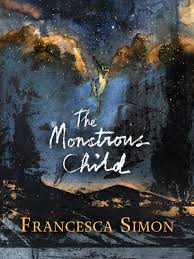Inspiring Young Readers
 posted on 07 Jul 2016
posted on 07 Jul 2016
The Monstrous Child by Francesca Simon
Hel is born with normal human like top half but with an unpleasant corpse like rotting bottom half - so she has not had a good beginning to her immortal life. Her mother, a giantess seems to despise her, perhaps disappointed that her third born is still rather difficult to like, although she is marginally better looking than her fierce siblings the snake, Jormungand and the wolf, Fenrir that came before her.
This Norse dysfunctional family lives in Jotunheim, home of the Giants. Hel's father, Loki is a god and visits them occasionally but can't bear to see any of his children and always fights violently with their mother.
When the three children are kidnapped in order to foil a prophecy that endangers the future of the gods and are taken to Asgard, things don't get a whole lot better. In the short time that she is there Hel meets her half siblings , who hate her and some other gods who also treat her with disdain - apart, that is, from the gorgeous, kind but unattainable god Baldr with whom she falls madly in love, possibly because this is her only positive experience of a relationship. But these encouraging developments in her life soon come to an abrupt end when she is cast out by Odin into Niflheim, doomed to become Queen of the Dead - not a prospect that she relishes at all.
However, once she arrives there, grumpily shakes herself down and then orientates herself to her new position, she learns to use her powers to command. At last she feels her existence has a real purpose and as part of this she enthusiatically lists her plans for building a new grand citadel with a lavish private bedchamber at its centre.
This part of the story includes some wonderfully evoked scenes tumbling with rich adjectives and metaphor. For instance, struggling to convey the remembered beauty of Asgard, she explains to Modgud the pale giantess who guards the bridge to Niflheim from Midgard, that green is like gangrene, red like blood, blue like bruises and yellow like pus.
This strange story is written in the wry, sardonic and often bitter voice of a female adolescent character who is not at all happy with her lot - and she does have quite a lot to complain about it must be said. The author explains that she was fascinated by the idea of presenting a slice of Norse mythology from the perspective of a child. As a scholar of Old and Middle English at Oxford and then Medieval Studies at Yale, she clearly knows her stuff and communicates it with great panache.
This is essentially a comic novel and I like Hel's condensed list of events from the beginning of time through to the End of World including ' Black Death - yes yes yes' and ' Antibiotics - boo'. Power brings responsibility and she soon realise that she must have servants to look after her needs, but how to select them from such a motley, stinking crew of corpses:
'Wraiths and cadavers, decaying and freshly buried; fretful spirits fluttering about like greasy shadows; and corpses with peeling skin and maggots dripping from their heads'
She assures us that death is a great leveller and takes some delight in the disappointment and anger of those who believe they deserve better in the after life. She welcomes gifts of treasure but scorns everything else that the dead bring along, summed up as 'a grisly bring and buy sale held on a reeking rubbish tip'. By the last few chapters in the book she is well into her stride bemoaning the limited advantages of being Queen of the Dead. It rather reminded me of the hilarious depiction of the devil by Andy Hamilton in the comedy radio series , ' Old Harry's Game' as Hel rants about the huge boredom, the unremitting stench, the over crowdedness, the lack of respect, the constant moaning and complaining.
By the end of the book, Hel is even angrier than at the beginning as her various plans for revenge on the gods seem to be thwarted. Without giving away the plot, she then makes an unexpected friend who persuades her that she can influence her fate which she does. Not exactly a happy ending but a positive one.
I would be interested to know how this book is received by a Young Adult audience as it took me quite while to like it. Perhaps some prior knowledge of Norse mythology would be helpful and I'm not sure how many readers would have this. I would imagine that a love of the fantasy genre may also be helpful but I don't much like that genre of fiction. Neither of course is it anything like the ' Horrid Henry' series which is aimed at much younger readers for which this writer is renowned. I must confess that her success with Horrid Henry is the reason that I bought the book because I knew she was an established writer with a reputation and I wanted to see how she handled something very different. I am pleased to say that I can recommend it as a a well written, melodramatic and funny tale with - ultimately - something like a happy ending.
Karen Argent
7th July 2016